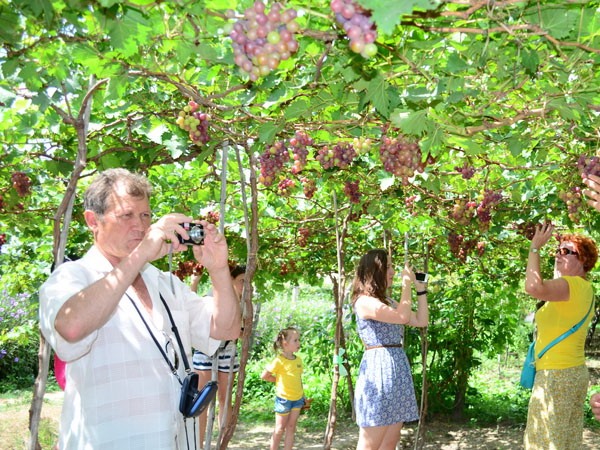 Economy
Economy

The central province of Ninh Thuận plans to expand its grape cultivation area by 7,900 hectares, of which more than 2,550ha will be safe grape fields, according to the provincial People’s Committee.
 |
| Tourists visit Ba Mọi grape farm in the central province of Ninh Thuận. The province plans to expand its grape cultivation area by 7,900 hectares, of which more than 2,550 ha are safe grape fields. — VNS File Photo |
HCM CITY — The central province of Ninh Thuận plans to expand its grape cultivation area by 7,900 hectares, of which more than 2,550ha will be safe grape fields, according to the provincial People’s Committee.
Speaking on Saturday on the sidelines of the International Grape and Wine Festival being held in the province, Lê Văn Bình, vice chairman of the provincial People’s Committee, said the industry aimed to transfer technology, import more grape varieties and create a geographical brand for locally produced wine and grapes.
Bình said the province plans to create the country’s largest grape cultivation area.
However, he noted that a number of challenges remained, including climate change and poor facilities and technologies, which affected grape quality and productivity.
In addition, local grapes and grape products cannot compete with imported products.
So far only eight businesses have been certified as “Ninh Thuận grape” by the province’s grape association.
Many of the businesses are family-owned with limited cultivation area. Many of them fail to apply cutting-edge technologies in cultivating safe grapes.
The festival and seminar gave farmers an opportunity to learn from local and foreign experts about the latest technologies, and find markets for grapes and grape products, such as raisins, jelly, jams and wine.
According to Bình, the province should continue building a geographic brand for grape and grape products in Ninh Thuận in order to create a brand name for the products in the province.
Linkages among grape growers, producers and experts should also be strengthened to help improve the grape industry, he added.
Nguyễn Văn Mọi, vice chairman of the Ninh Thuận Grape Association, said the province should build a research centre for grapes and wine.
Mọi said the quality of wine was still low and that wine production lacked advanced facilities and technologies.
Wine production needs local raw materials instead of imports from other countries, he added.
He called on businesses to invest in technology transfer in grape cultivation for the farmers.
There are nearly 1,200 households cultivating grapes that conform to VietGAP standards with a total cultivated area of 280ha.
A local grape farmer, who declined to be named, said farmers in Ninh Thuận Province were facing many challenges, including a lack of raw materials for wine making, advanced technologies and stable outlets for their products.
So far, there are 46 businesses producing grape wine with an output of 230,000 litres per year, according to the province’s People’s Committee.
Each year, nearly 800 tonnes of grape and grape products and 15,600 bottles of wine and jelly are consumed.
The province has attracted three grape-cultivation projects with a total investment of VNĐ304 billion (US$13.54 million).
Grapes, which are a highly valued staple crop in Ninh Thuận Province, were first introduced to the province in 1960 and test-planted by the South Central Centre for Agricultural Technical Research based in Ninh Sơn District. Commercial production began in the 1980s.
The province currently has more than 1,100 hectares of grape fields with an average yield of 25 tonnes of fresh grapes per hectare per year. — VNS